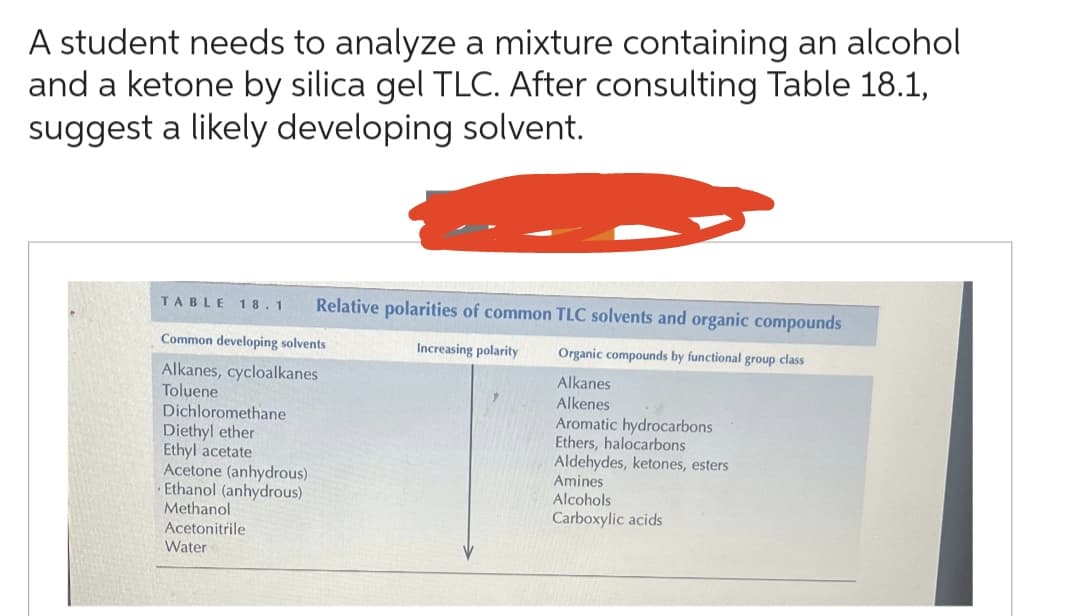A student needs to analyze a mixture containing an alcohol and a ketone by silica gel TLC. After consulting Table 18.1, suggest a likely developing solvent. TABLE 18.1 Relative polarities of common TLC solvents and organic compounds Common developing solvents Organic compounds by functional group class Alkanes, cycloalkanes Alkanes Toluene Alkenes Aromatic hydrocarbons Ethers, halocarbons Dichloromethane Diethyl ether Ethyl acetate Acetone (anhydrous) Ethanol (anhydrous) Methanol Acetonitrile Water Increasing polarity nydes, ketones, esters Amines Alcohols Carboxylic acids
A student needs to analyze a mixture containing an alcohol and a ketone by silica gel TLC. After consulting Table 18.1, suggest a likely developing solvent. TABLE 18.1 Relative polarities of common TLC solvents and organic compounds Common developing solvents Organic compounds by functional group class Alkanes, cycloalkanes Alkanes Toluene Alkenes Aromatic hydrocarbons Ethers, halocarbons Dichloromethane Diethyl ether Ethyl acetate Acetone (anhydrous) Ethanol (anhydrous) Methanol Acetonitrile Water Increasing polarity nydes, ketones, esters Amines Alcohols Carboxylic acids
Chemistry
10th Edition
ISBN:9781305957404
Author:Steven S. Zumdahl, Susan A. Zumdahl, Donald J. DeCoste
Publisher:Steven S. Zumdahl, Susan A. Zumdahl, Donald J. DeCoste
Chapter1: Chemical Foundations
Section: Chapter Questions
Problem 1RQ: Define and explain the differences between the following terms. a. law and theory b. theory and...
Related questions
Question

Transcribed Image Text:A student needs to analyze a mixture containing an alcohol
and a ketone by silica gel TLC. After consulting Table 18.1,
suggest a likely developing solvent.
TABLE 18.1 Relative polarities of common TLC solvents and organic compounds
Common developing solvents
Increasing polarity Organic compounds by functional group class
Alkanes, cycloalkanes
Alkanes
Toluene
Alkenes
Aromatic hydrocarbons
Ethers, halocarbons
Dichloromethane
Diethyl ether
Ethyl acetate
Acetone (anhydrous)
Ethanol (anhydrous)
Methanol
Acetonitrile
Water
nydes, ketones, esters
Amines
Alcohols
Carboxylic acids
Expert Solution
This question has been solved!
Explore an expertly crafted, step-by-step solution for a thorough understanding of key concepts.
This is a popular solution!
Trending now
This is a popular solution!
Step by step
Solved in 3 steps with 3 images

Knowledge Booster
Learn more about
Need a deep-dive on the concept behind this application? Look no further. Learn more about this topic, chemistry and related others by exploring similar questions and additional content below.Recommended textbooks for you

Chemistry
Chemistry
ISBN:
9781305957404
Author:
Steven S. Zumdahl, Susan A. Zumdahl, Donald J. DeCoste
Publisher:
Cengage Learning

Chemistry
Chemistry
ISBN:
9781259911156
Author:
Raymond Chang Dr., Jason Overby Professor
Publisher:
McGraw-Hill Education

Principles of Instrumental Analysis
Chemistry
ISBN:
9781305577213
Author:
Douglas A. Skoog, F. James Holler, Stanley R. Crouch
Publisher:
Cengage Learning

Chemistry
Chemistry
ISBN:
9781305957404
Author:
Steven S. Zumdahl, Susan A. Zumdahl, Donald J. DeCoste
Publisher:
Cengage Learning

Chemistry
Chemistry
ISBN:
9781259911156
Author:
Raymond Chang Dr., Jason Overby Professor
Publisher:
McGraw-Hill Education

Principles of Instrumental Analysis
Chemistry
ISBN:
9781305577213
Author:
Douglas A. Skoog, F. James Holler, Stanley R. Crouch
Publisher:
Cengage Learning

Organic Chemistry
Chemistry
ISBN:
9780078021558
Author:
Janice Gorzynski Smith Dr.
Publisher:
McGraw-Hill Education

Chemistry: Principles and Reactions
Chemistry
ISBN:
9781305079373
Author:
William L. Masterton, Cecile N. Hurley
Publisher:
Cengage Learning

Elementary Principles of Chemical Processes, Bind…
Chemistry
ISBN:
9781118431221
Author:
Richard M. Felder, Ronald W. Rousseau, Lisa G. Bullard
Publisher:
WILEY